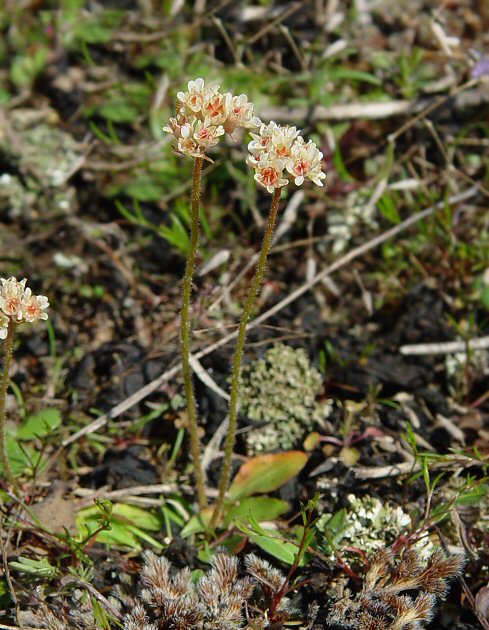Micranthes texana (Buckley) Small
Saxifrage

Native
CC = 9
CW = 5
MOC = 10
© DETenaglia
Micranthes texana (Buckley) SmallSaxifrage | |
 |
Native CC = 9 CW = 5 MOC = 10 |
© DETenaglia |
|
Family - Saxifragaceae Habit - Perennial forb, from a bulbous fleshy whitish cormlike base with fibrous roots, clumping. Stems - Scape to 7 cm tall, sparsely to densely hairy (some of the hairs with reddish glandular apices), herbaceous, erect.
Leaves - Basal, petiolate, 1-5 cm long, tapered or narrowed to a sessile base or a flattened, mostly winged petiole to 15 mm long, firm and crisp, often with reddish margins, the surfaces glabrous or nearly so, the margins somewhat wavy to relatively coarsely and irregularly scalloped or toothed.
Inflorescence - Terminal compact capitate clusters of cymules, 3-30 cm long, remaining more or less condensed, not becoming more open and lax later in the flowering season, the main axis sparsely moderately pubescent with somewhat spreading, crinkly, multicellular, gland-tipped hairs, becoming sparsely hairy or glabrous toward the short branch tips. Each cymule subtended by a thin linear bract, these often reddish near apex.
Flowers - Sepals 5, 1.2-2.0 mm long at flowering, not becoming elongated at fruiting, remaining ascending after the flower opens, oblong-ovate, rounded to bluntly pointed at the tip, often prominently reddish-tinged, especially along the margins, glabrous. Petals 5, 2.0-3.5 mm long, oblong-elliptic to obovate, distinct, white, glabrous, to 3mm in diameter. Stamens 10, arising from base of petals and sepals. Pistils with usually 3 or 4 carpels, mostly broadly ovoid. Ovary inferiorm, with axile placentation. Ovules numerous. Styles 3, green, 1.3 mm long.
Fruits - Capsules 3-4 mm long (including the stylar beaks). Seeds numerous, 0.7-1.1 mm long, asymmetrically ovoid in outline, with several fine longitudinal ribs, these usually with minute tubercles or papillae, reddish brown or dark brown. Flowering - April - May. Habitat - Sandstone glades and rocky prairies, on sandstone and chert substrates. Origin - Native to U.S. Lookalikes - M. virginiensis. Other info. - This little glade plant is found in Missouri only within a tight region in the southwestern portion of the state. Its range beyond Missouri is almost entirely restricted to five states to our south and west. The small clusters of white flowers stand out on their rocky substrata, and typically the plant occurs in large colonies. This plant can be distinguished from the related M. virginiesis in that it stays small and compact even after flowering. The latter plant gets quite a bit taller and also occurs in more eastern counties of the state. Another closely related species, M. palmeri, is found in several Arkansas and Oklahoma counties which border Missouri. Though this species has not been documented from Missouri yet, there is every reason to expect that it will appear here eventually, or is even here already and has simply been overlooked. This species has leaf blades with entire or nearly entire margins, as well as inflorescence axes with somewhat longer, less crinkly, less glandular hairs, the branches becoming sparsely hairy or glabrous toward the tips. This species should be searched for in southwestern counties, in acidic glade habitats similar to those of M. texana. Photographs taken at Dave Rock Conservation Area, St. Clair County, MO., 4-3-04. |